Actual yield: 6.5% /year
Associated risk: Moderate
Horizon of investment : 18 mois
Summary
Strengths of the operation :
- Tax advantage: Eligibility for the PEA-PME, providing an exemption from income tax.
- No fees for investors: No registration, management, subscription, or performance fees.
- Platform reliability: Exemplary track record of Enerfip, with no repayment defaults since its creation in 2015.
- Stable contractual framework: Secured electricity purchase contracts with EDF.
Weak points of the operation :
- Lack of initial details: The essential information about the project leader (revenue, founders' experience, achievements) was not sufficiently detailed on the initial presentation page.
- Minimum investment via PEA-PME: Possibility to invest starting from €10, except for PEA-PME that had to invest a minimum of €2,500.
- Total loss risk: Crowdfunding is very binary. It either works, or it doesn't.
Context
For decades, ecology and investment seemed irreconcilable. On one side, ecology pointed to the capitalist values of our society, while on the other, investors viewed ecological projects as risky and unprofitable.
However, a new generation of young savers has recently emerged, driven by the desire to support responsible initiatives. Beyond the pursuit of returns, these savers want to have a direct impact by supporting simple, concrete things on a scale they can manage, in contrast to a traditional financial system often perceived as a complex and inaccessible behemoth.
This evolution has allowed the emergence of new players such as Green-Got, Lita.co Lendosphere, which contribute to gradually transforming the French financial landscape.
How to invest in renewable energy?
A solution particularly appeals to new investors due to its simplicity: citizen crowdfunding, also known as investment crowdfunding. The principle is simple: a project to finance and a common pot where everyone can invest according to their means.
This financing method can be adapted to fund very different projects, such as the creation of an eco-district (real estate), the launch of a young company (private equity) or even the development of a wind farm (renewable energy). In return, investors generally receive annual interest ranging from 5 to 10% (bonds) or shares in the company concerned (unlisted stocks).
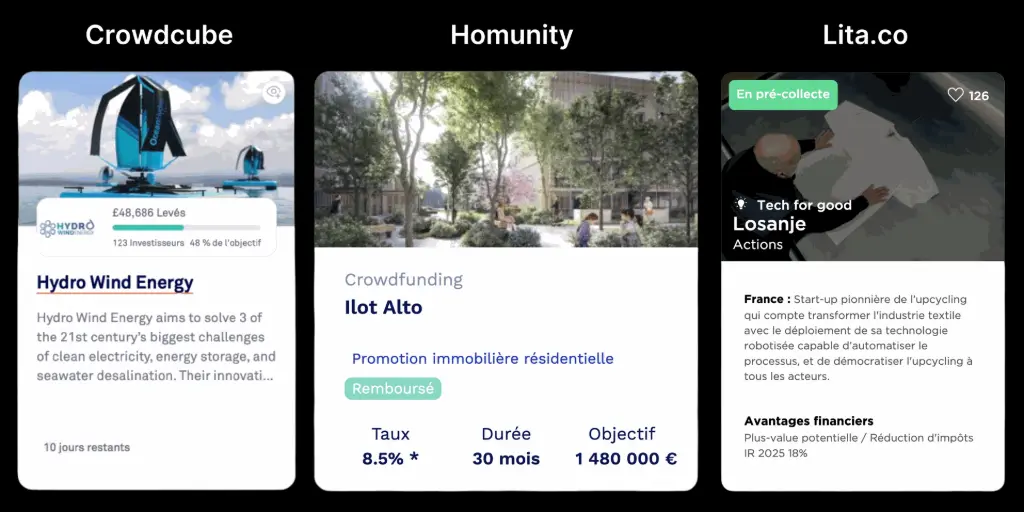
Of course, this is not the only way to invest in renewable energy. Other options are available to you:
- Acheter des actions d’entreprises spécialisées (ex. : Ørsted, Vestas Wind Systems, Enphase Energy) ou des ETF (iShares Global Clean Energy).
- Investir dans des coopératives locales qui financent des installations renouvelables (ex. : Enercoop).
- Acquérir des obligations vertes émises pour financer des projets environnementaux et durables (ex. : Amundi ESG Euro Corporate Bond Ex Financials (DR) UCITS ETF P Acc).
- Installer des panneaux solaires pour réduire vos factures d’énergie et vendre l’excédent au réseau.
A forthcoming article will detail each of these opportunities. For now, let's focus on the star of the day: crowdfunding in renewable energy.
To explore this option, I tested two platforms: Lendopolis, recently acquired by Lendosphere, and Enerfip. Over time, I gradually moved away from Lendopolis to focus exclusively on Enerfip, which better meets my expectations on all levels.
Presentation of Enerfip
Enerfip est une plateforme française de financement participatif entièrement dédiée aux projets d’énergies renouvelables (éolien, solaire, hydroélectricité, biomasse, etc.). Fondée en 2014, elle bénéficie aujourd’hui de l’agrément de l’Autorité des Marchés Financiers (AMF) et est régulée par l'Autorité de Contrôle Prudentiel et de Résolution (ACPR).
Enerfip allows you to invest from €10, with no fees for investors. Since its inception, it has facilitated the financing of nearly 500 projects, with exemplary management: no payment delays or defaults have been reported in the past six years.

Enerfip ne cesse de se développer et, après s’être imposée en France, elle étend désormais ses activités à l’Espagne, à l’Italie et aux pays du Benelux
Note : Si j’apprécie autant cette plateforme, c’est parce que de la souscription d’une offre au suivi de mes investissements, tout est intuitif, rapide et parfaitement organisé. Mon espace investisseur centralise toutes les informations dont j’ai besoin :
- A detailed schedule to track repayments,
- The documents related to my investments,
- The complete history of my operations,
- A multitude of numerical data very useful for analyzing my investments.
My complete analysis of Enerfip
In which project did I invest?
This operation, which is the first of the 21 projects I have helped to finance on Enerfip, has some specific features that make it an excellent case study.
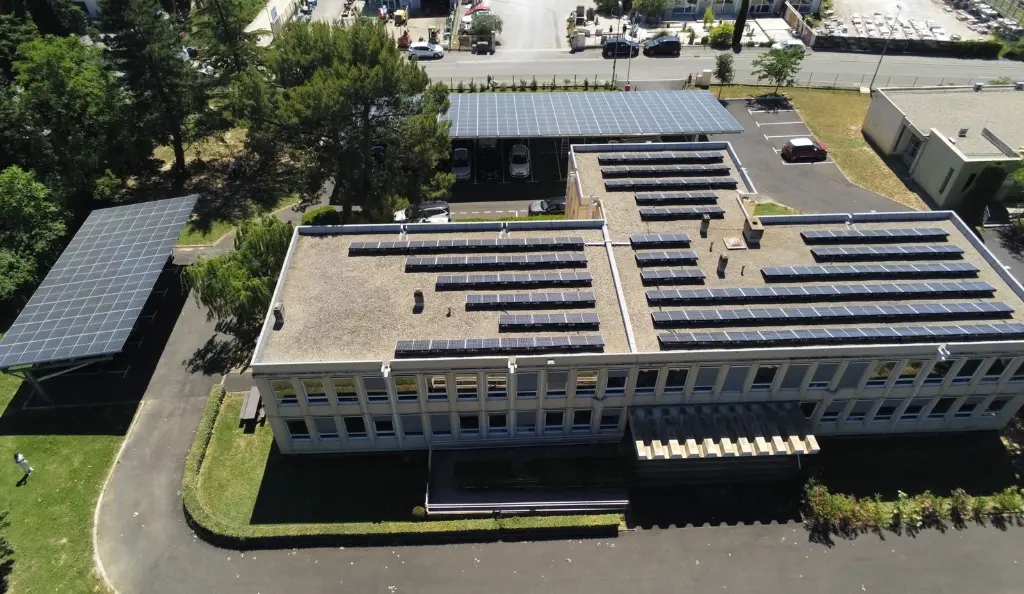
Let's start by recalling why companies turn to platforms like Enerfip to raise funds. Generally, these companies seek to finance their equity to obtain a bank loan. Instead of using their reserves, they borrow, for example, 2 million euros at 6% from Enerfip users, and then use it as equity to secure a larger bank loan, such as 15 million euros at 3%, necessary for the project's realization.
However, the project I invested in was a bit different. The €2,400,000 raised that day by the project leader was directly intended to finance the work itself. These funds were used to build a portfolio of 12 photovoltaic roofing projects located in the PACA region: 4 in the Hautes-Alpes and 8 in the Alpes-de-Haute-Provence.
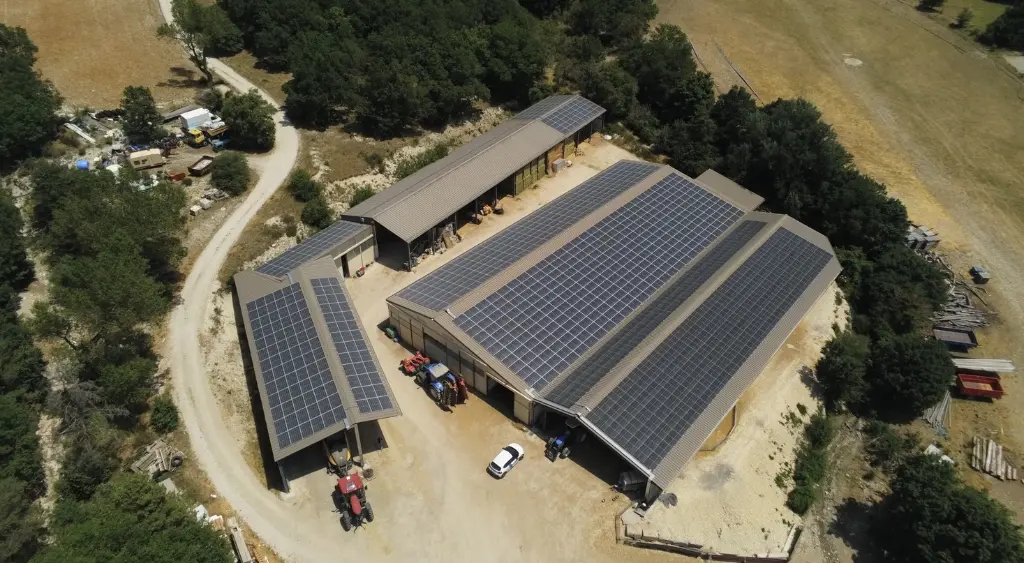
Loan conditions
- Financial instrument: Simple bonds
- Value of each bond: €10
- Loan duration: 18 months (1.5 years)
- Interest rate: 6.5%/year
- Fiscalité : Française.
- Accessible: PEA-PME or not.
- Investissement minimum : 10 €
- Montant recherché : 2 400 000 €
- Repayment: in fine (at the end of the 18 months)
- Payment of interest: at maturity
- Rank of crowdfunding: Senior (see section "Associated Risks")
- Participants: 1195 eco-savers
Last important detail, if I invested €5,000 in this operation, instead of €500 as I usually do, it’s not that I made a mistake with the number of zeros. This opportunity allowed for investment through a PEA-PME, a scheme offering tax advantages that I detail in the “Taxation” tab of this article.
Note : Il s’agit d’une énorme erreur de ma part d’avoir investi 5 000 € pour une première opération sur une plateforme qui avait moins de 10 ans d’existence. Par la suite, je n’ai jamais pu avoir un portefeuille équilibré et ma performance globale était complètement dépendante de la réussite de ce projet. Heureusement, sans conséquence.
The partner
Avec 15 années d’expérience et une équipe de 32 collaborateurs, Silversun est un acteur clé du photovoltaïque, enregistrant en 2023 un chiffre d’affaires de 25,9 millions d’euros, avec une marge brute de 56,2 %.
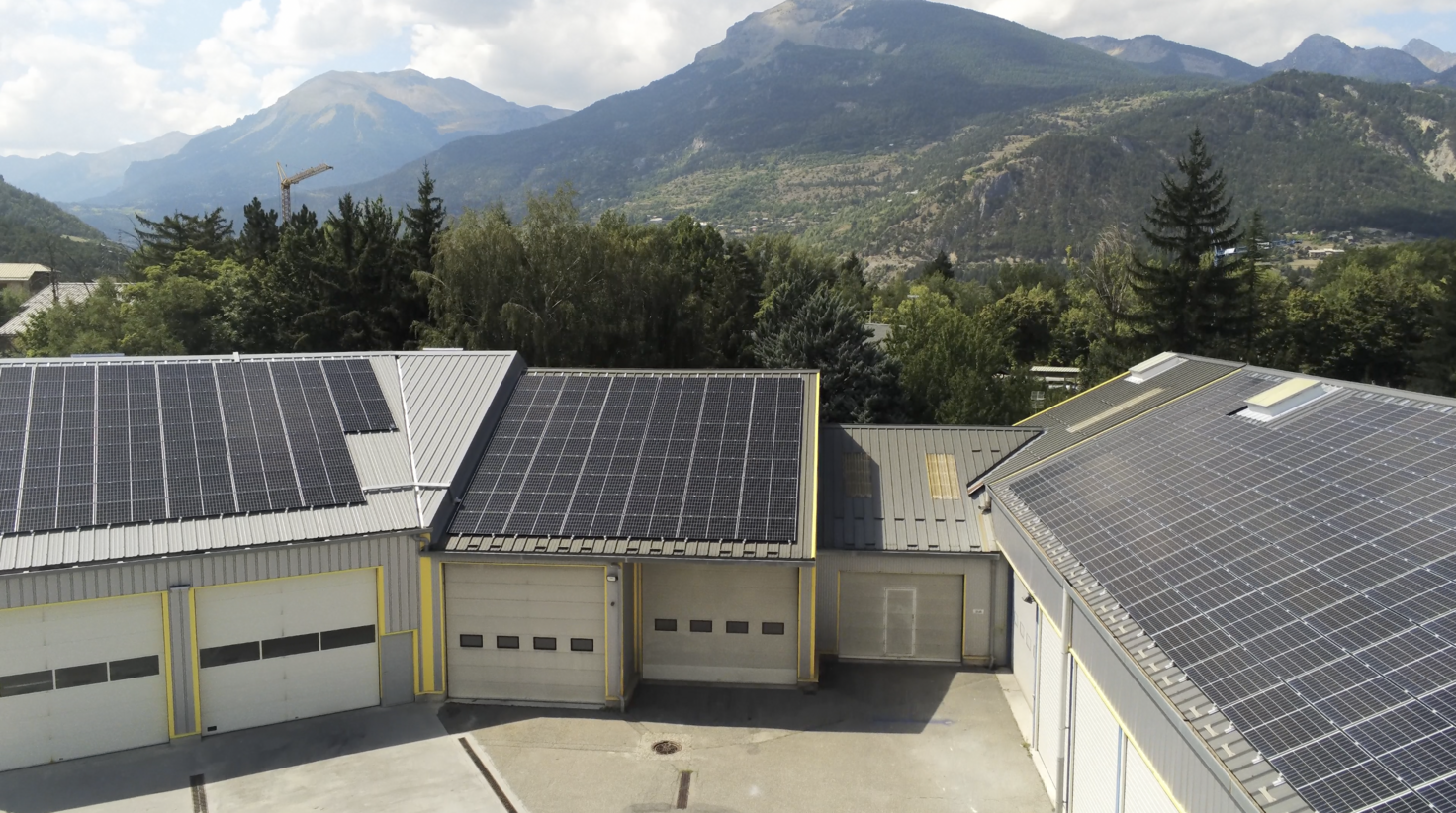
The company offers a variety of solutions: self-consumption, energy resale, turnkey projects, or partnerships with third-party investors. It has strong expertise in the development, construction, and operation of photovoltaic power plants on rooftops, on the ground, and in canopies.
Note : J’ai dû mener une due diligence beaucoup plus approfondie sur cette entreprise, car la présentation du projet sur la page dédiée manquait d’informations essentielles. Des données clés, telles que le chiffre d’affaires, le nombre de réalisations ou encore l’expérience des dirigeants, étaient absentes. Ces éléments me semblent pourtant indispensables pour évaluer la fiabilité et la crédibilité du porteur de projet, et donc la confiance qu’on peut lui accorder.
The course of the operation
- Project presentation
Several days before the launch of the fundraising campaign, the project’s dedicated page was made live in the “upcoming investments” section of the “invest” tab on Enerfip. It contained detailed information, including:
- Les caractéristiques de l’offre : type de titre financier, taux d'intérêt, durée d’investissement, notation du projet (niveau de risque), fiscalité et mode de remboursement.
- L’impact du projet : puissance installée (en mégawatts crête, MWc), production annuelle estimée (en mégawattheures, MWh), montant total de l’investissement.
- Information about the project holder, although incomplete.
- A summary of the associated risks.
- The date and time of the collection opening.
2. The collection phase
The fundraising started as planned, successively reaching the success threshold and then the cap. If the initial goal had not been met within the allotted time, the fundraising would have been canceled, and the funds fully refunded to the investors.
Ultimately, it was 1,195 eco-savers who helped raise the €2,400,000 needed to carry out the project.
Note: I invested through my PEA-PME. I therefore sent the file provided by Enerfip to BforBank so that they can take care of everything.
3. The reimbursement
Le remboursement
18 mois plus tard, j’ai reçu le remboursement intégral de mon investissement de 5 000 €, directement crédité sur mon compte PEA-PME BforBank, accompagné de 495,34 € d’intérêts.

Result of the operation
Lorsque je retirerai les 495,34 € générés par mon investissement via mon PEA-PME, ils seront soumis à 17,2 % de prélèvements sociaux (CSG, CRDS, etc.), soit une retenue de 85,20 €.
Mon bénéfice net, après frais et fiscalité, s’élève donc à 410,14 €.
Mais au-delà de cet aspect financier, l’impact environnemental de cet investissement est particulièrement satisfaisant. Les 12 projets photovoltaïques installés sur des toitures de bâtiments existants produisent désormais chaque année 3 037 MWh d’électricité renouvelable. Cette production équivaut à :
- The annual electricity consumption of 1,356 people, which accounts for 7% of the total consumption of the city of Sète.
- Une réduction des émissions de CO2 de 2 994 tonnes par an, grâce à cette énergie décarbonée.
À titre personnel, avec mes 5 000 € investis, j’ai contribué à la production d’environ 6 335 kWh par an, ce qui représente 233 % de la consommation électrique 2024 de ma compagne et moi.
The setup used
Silversun Technics, the parent company, is the issuer of the bonds and the main stakeholder of the project. Its role is to coordinate the design, construction, and overall management of the photovoltaic power plants.
To legally and financially manage this portfolio of 12 roofs, she created two entities (Silversun 07 and Silversun 04) known as SPVs (Special Purpose Vehicles). In order to have an administrative distinction for each of the projects, she does the same with the various construction sites she oversees.
All these SPVs are grouped under a single legal entity of the group called Silversun Prod. This has the advantage of separating risks. If one project encounters difficulties, the other projects carried by different SPVs are not directly affected.
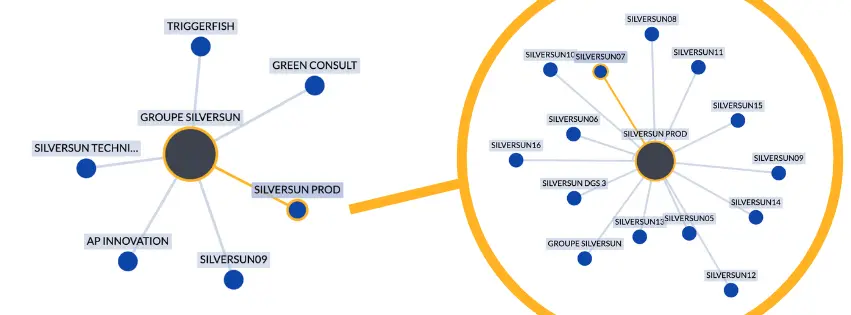
Silversun 07 et Silversun 04, en tant que sociétés de projet (SPV), détiennent les droits relatifs aux projets photovoltaïques, tels que les baux, les permis de construire et les contrats de raccordement. Une fois les centrales photovoltaïques construites, elles assurent leur exploitation et gèrent les flux financiers issus de la vente d'électricité. De plus, les revenus générés par ces SPV peuvent bénéficier de
De plus, les revenus générés par ces SPV peuvent bénéficier de dispositifs fiscaux locaux favorisant les énergies renouvelables, such as exceptional depreciation for the acquisition of equipment intended to save energy and renewable energy production equipment.
Les risques associés
Comme tout investissement, investir dans des projets responsables comporte des risques qu'il est important de comprendre. Parmi eux, on note :
- Le risque de retard dans la construction, voire de non-achèvement des ouvrages, pouvant compromettre la rentabilité.
- Technological risk: although reliable, the equipment may encounter malfunctions or unavailability affecting production.
- De plus, un défaut de remboursement à échéance ou des évolutions réglementaires imposant de nouveaux coûts peuvent fragiliser les projets.
If one of these issues leads to the non-repayment of obligations, then it will be necessary to successfully complete many other operations to return to balance.
Pour atténuer ces risques, Enerfip a mis en place quelques mécanismes de sécurité :
- Les actifs des SPV (les centrales photovoltaïques) sont nantis, ce qui signifie qu’ils peuvent être liquidés pour rembourser les obligations en cas de défaillance.
- De plus, les obligations émises par Silversun Technics sont de rang senior. Cela veut dire qu’en cas de liquidation judiciaire, leur remboursement est prioritaire par rapport aux autres dettes.
- The projects benefit from electricity purchase contracts signed with EDF, ensuring stable long-term income.
Note : No one talks about the main risk of crowdfunding. Unlike the stock market, where a loss can range from -0.1% to -99.99%, crowdfunding operates on a binary logic: either the investment succeeds and you receive what was promised, or the project fails, resulting in a total loss of your capital.
What is a constraint is also an advantage: if everything goes as planned, you receive the predetermined gain from the start, which contrasts with the stock market where profits are never predictable.
Même si Enerfip a démontré une excellente sélection de projets jusqu’à présent, il est crucial de bien vous diversifier. Cela vaut autant pour votre patrimoine global que pour la répartition de vos investissements entre différents projets participatifs.
Fees and taxation
Fees
One of Enerfip's great strengths lies in the ability to invest without:
- No registration fee
- No subscription fees
- No management fees
- No performance fees
This model is made possible by the fact that Enerfip derives its revenue exclusively from project holders. The latter pay the platform a commission, called a "success fee," which ranges from 2% to 10% including tax of the amount collected, if the fundraising success threshold is reached.
This percentage is negotiated in advance with each project holder, taking into account the complexity and specific characteristics of the financing.
Note : This approach is particularly rare in the field of investment. Most platforms that serve as intermediaries charge fees from both investors and project holders, which dampens our final performance.
Taxation
If I chose to analyze this operation rather than another, it is partly because of its specific tax advantage.
Ordinarily, when you invest in a project through Enerfip as an individual residing for tax purposes in France, the interest earned on your Enerfip account is considered as « produits de placement à revenu fixe ».
These interests are subject to income tax, just like the interest from standard bank savings accounts (excluding regulated accounts such as the Livret A or the LDD). By default, the flat tax (PFU), also known as Flat Tax, applies to these earnings.
To simplify, this means that 30% of your earnings (17.2% in social contributions and 12.8% in income tax) are withheld by the tax authorities.
Cependant, certaines opérations, comme celle-ci, sont éligibles au PEA-PME (Plan d’Épargne en Actions destiné aux Petites et Moyennes Entreprises). Ce dispositif est conçu pour encourager l’investissement dans les entreprises de taille intermédiaire, non cotées ou cotées sur des marchés secondaires.
Tax advantages of the PEA-PME
By subscribing to this type of project through a PEA-PME, the interest and capital gains generated are exempt from income tax, provided that a minimum holding period of 5 years is respected. Only social contributions (17.2%) remain applicable. This favorable tax framework allows you to maximize your net gains while supporting local and innovative companies in the renewable energy sector.
Note : Dans le cadre de cette opération, l’investissement minimum initialement fixé était de 2 500 €. Il est désormais passé à 3 000 € pour les futurs projets éligibles.
